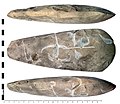 | |
 | |
| Established | 1893 |
|---|---|
| Location | Castle Street, Carlisle CA3 8TP, England, United Kingdom |
| Coordinates | 54°53′43″N2°56′26″W / 54.8952°N 2.9405°W |
| Visitors | 240,000 (2018) [1] |
| Chairman | Andrew Smith [2] |
| Director | Andrew Mackay [3] |
| Website | tullie |
Tullie House Museum and Art Gallery, officially known as Tullie since July 2024, is a museum in Carlisle, England. Opened by the Carlisle Corporation in 1893, the original building is a converted Jacobean mansion, with extensions added when it was converted. At first the building contained the museum and also a library, an art school and a technical school. [4] [5]
Contents
- Collections
- Musical instruments
- Roman Britain
- Post-Roman history
- Accolades
- Gallery
- See also
- References
- External links
Tullie reopened on 26th April 2025 after extensive redevelopment. [6]
The building, including the extensions, is a Grade I listed building, [4] and the wall, gates and railings in front of the house are separately Grade I listed. [7]
The two schools were moved in the 1950s and the library in 1986. The museum expanded into the city Guildhall in 1980 and with new space available from 1986 it underwent an extensive redevelopment over 1989–90 and again in 2000–01.
Since May 2011 the museum has been an independent charitable trust, the Tullie House Museum and Art Gallery Trust. [8] [ needs update ] It is one of the three members of the Cumbria Museum Consortium, along with Lakeland Arts and the Wordsworth Trust. [9] In 2012–15 and 2015–18 this consortium was one of the 21 museums or consortia (16 in the earlier period) to be funded by Arts Council England as "Major Partner Museums". [10]










